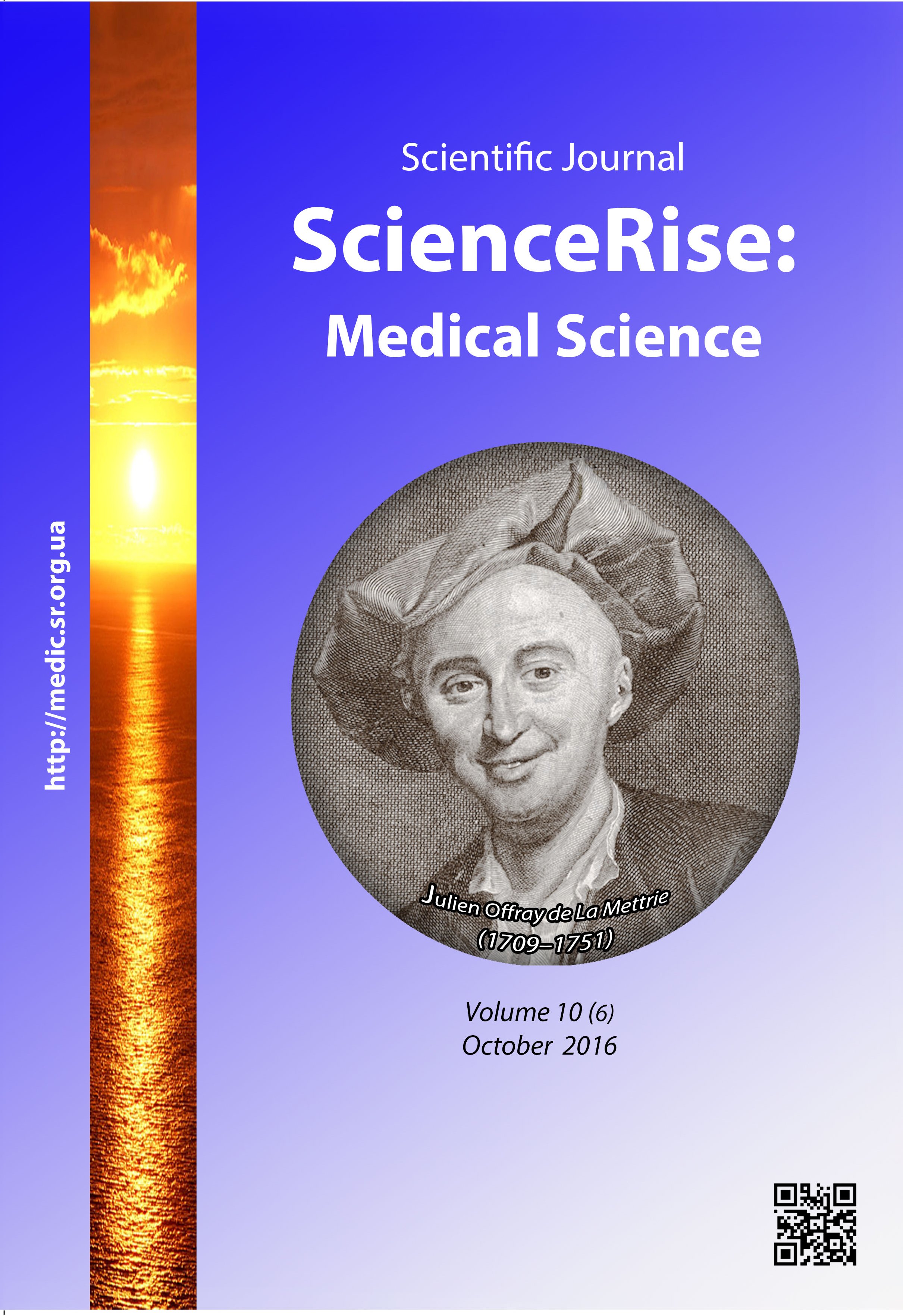Substantiation of the choice tactics for the treatment of multiple and associated fractures of long bones, depending on the injury severity and victims condition
DOI:
https://doi.org/10.15587/2519-4798.2016.80412Keywords:
multiply fractures, combined fractures, polytrauma, severity of victims condition, severity of injuryAbstract
The aim of the article is substantiation of the optimal tactics and volume of osteosynthesis of patients with multiple and combined fractures of the long bones, which polytrauma severity was 25–40 points according to ISS scale and condition severity according to MFS-IC, added with age indices, 21–32 points.
Methods. The clinical base of research included 104 patients of this category, divided in 2 groups by the sign of one-stage (main) or two-stage (group of comparison) operative treatment. The system of objective medical and social criteria of treatment efficacy, offered by the authors, allowed rather reliably determine the optimal character, volume and terms of operative interventions.
Results. The terms of main stages of fractures consolidation in patents with two-stage technique of osteosynthesis exceeded the analogous ones in patients with one-stage technique in 1,3–1,6 times; the severity of complications in patients, who underwent the two-stage treatment of multiple and combined fracture of the long bones were more than in victims with analogous traumas, who underwent the one-stage technique of osteoporosis; the terms of staying on the stationary treatment of patients, who underwent the one-stage treatment were 1,7times less than in ones, who underwent the two-state tactics of osteosynthesis; the mean terms of fractures consolidations in patients, who underwent the one-stage surgical treatment were 1,3–1,4 less by the all types of fractures and their combinations than in patients, who underwent the two-stage surgical treatment.
Conclusions. The one-stage realization of the all types of extrafocal and closed intramedullary blocking osteosynthesis is optimal for this category of patients
References
- Haas, N. P., Hoffmann, R. F., Mauch, C. et. al. (1995). The management of polytraumatized patients in Germany. Clinical orthopaedics and related research, 318, 25–35.
- Smith, J., Greaves, I., Porter, K. (Eds.) (2010). Oxford Desk Reference – Major Trauma. Oxford University Press. doi: 10.1093/med/9780199543328.001.0001
- Kutepov, S. M. (1996). Mesto vneochagovogo osteosinteza vlechenii postradavshih s tjazheloj travmoj taza. Genij ortopedii, 2-3, 93.
- Breitfuss, H., Fröhlich, R., Povacz, P., Resch, H., Wicker, A. (1996). The tendon defect after anterior cruciate ligament reconstruction using the midthird patellar tendon—a problem for the patellofemoral joint? Knee Surgery, Sports Traumatology, Arthroscopy, 3 (4), 194–198. doi: 10.1007/bf01466615
- Tscherne, H., Regel, G., Pape, H.-C., Pohlemann, T., Krettek, C. (1998). Internal Fixation of Multiple Fractures in Patients With Polytrauma. Clinical Orthopaedics and Related Research, 347, 62–78. doi: 10.1097/00003086-199802000-00009
- Meighan, A., Gregori, A., Kelly, M., MacKay, G. (1998). Pelvic fractures: the golden hour. Injury, 29 (3), 211–213. doi: 10.1016/s0020-1383(97)00183-6
- Berezka, M. I., Lapshyn, D. V., Lytovchenko, V. O., Spesyvyj, I. I. (2016). Porivnjal'na ocinka shkal shhodo prognozuvannja rezul'tatu likuvannja u postrazhdalyh iz politravmoju. Eksperymental'na i klinichna medycyna, 1, 155–161.
- Pape, H.-C., Giannoudis, P., Krettek, C. (2002). The timing of fracture treatment in polytrauma patients: relevance of damage control orthopedic surgery. The American Journal of Surgery, 183 (6), 622–629. doi: 10.1016/s0002-9610(02)00865-6
- Rindenko, V. G., Rindenko, S. V., Fes'kov, O. E. (2007). Hіrurgіchna taktika pri polіtravmі z zastosuvannjam koncepcії damage control. Medicina neotlozhnyh sostojanij, 26–31.
- Tumjan, S. D. (1983). K itogam diskussii ob ocenke ishodov lechenija perelomov dlinnyh trubchatyh kostej. Ortopedija travmatologija i protezirovanie, 6, 63–65.
Downloads
Published
How to Cite
Issue
Section
License
Copyright (c) 2016 Дмитро Вячеславович Лапшин

This work is licensed under a Creative Commons Attribution 4.0 International License.
Our journal abides by the Creative Commons CC BY copyright rights and permissions for open access journals.
Authors, who are published in this journal, agree to the following conditions:
1. The authors reserve the right to authorship of the work and pass the first publication right of this work to the journal under the terms of a Creative Commons CC BY, which allows others to freely distribute the published research with the obligatory reference to the authors of the original work and the first publication of the work in this journal.
2. The authors have the right to conclude separate supplement agreements that relate to non-exclusive work distribution in the form in which it has been published by the journal (for example, to upload the work to the online storage of the journal or publish it as part of a monograph), provided that the reference to the first publication of the work in this journal is included.









